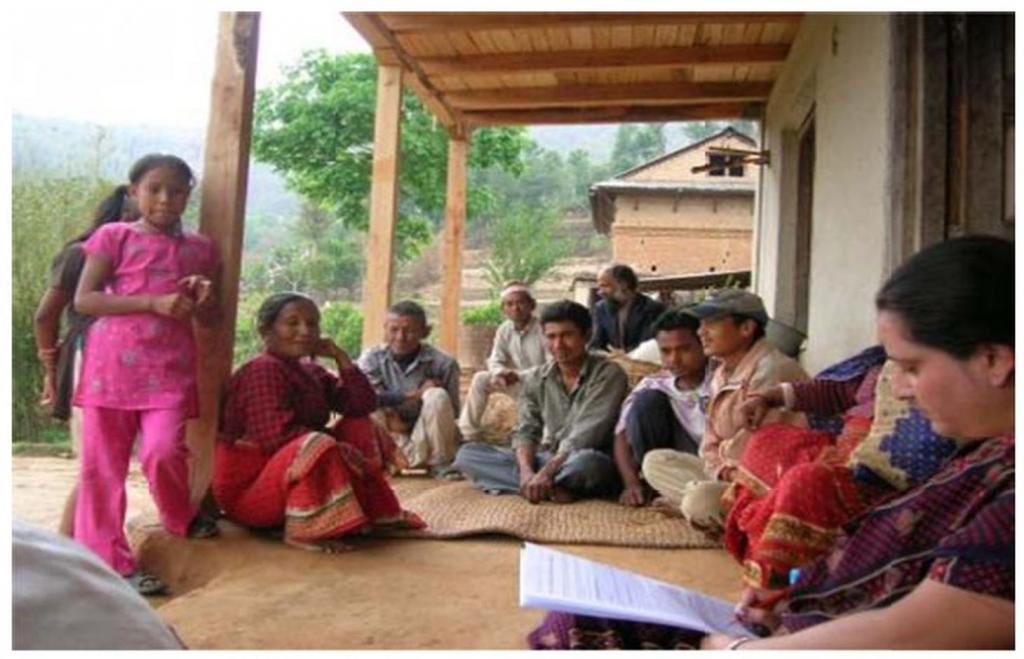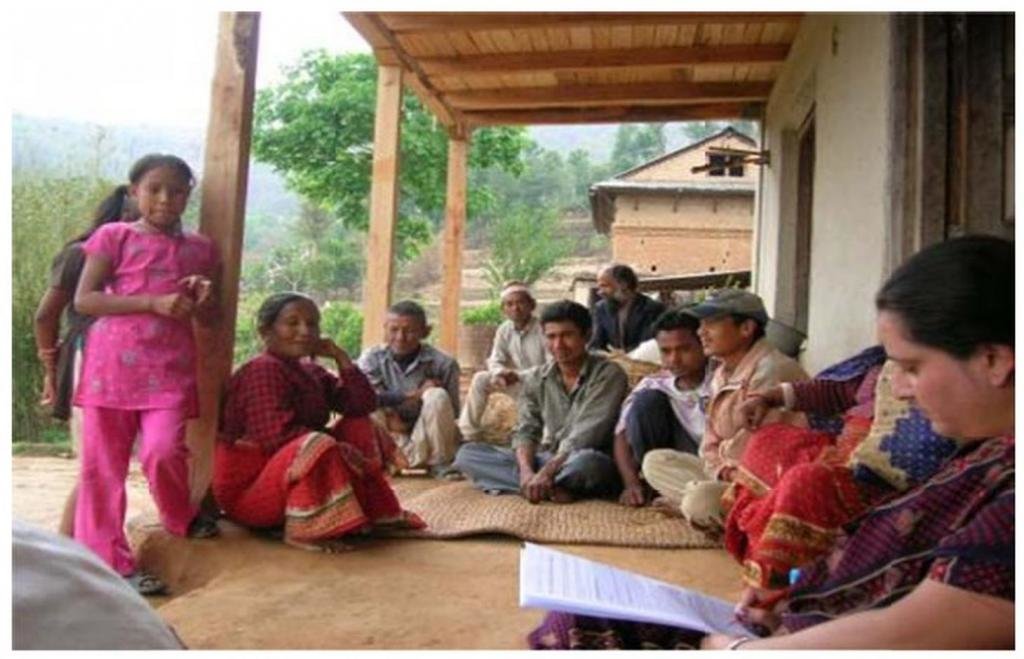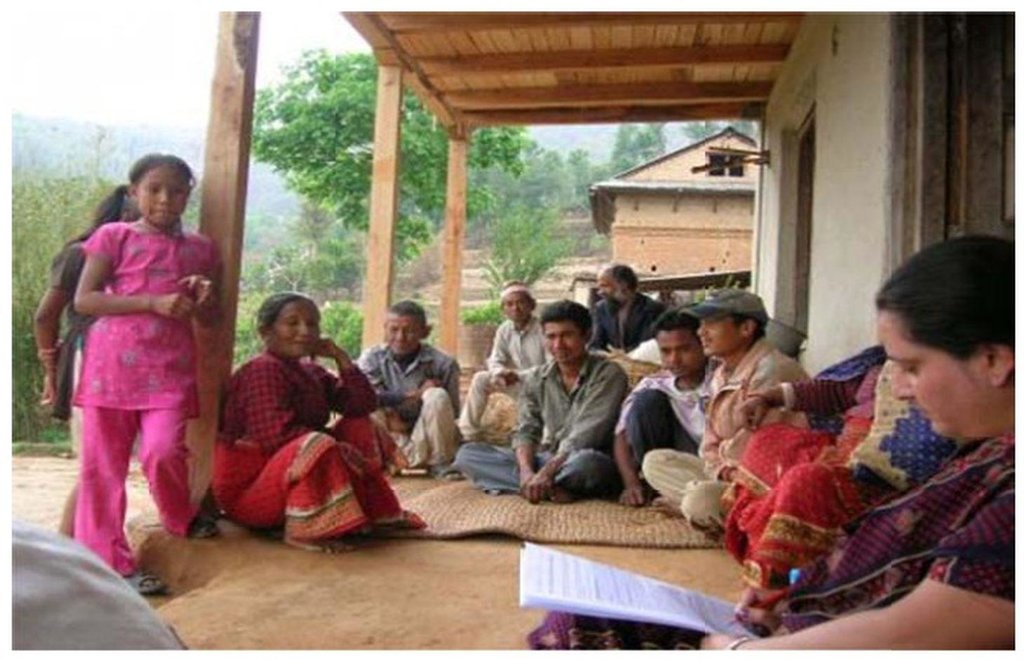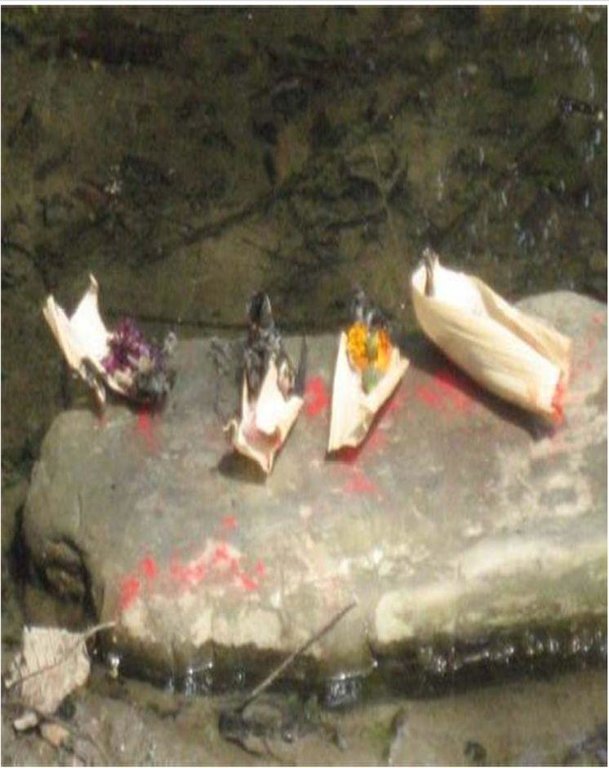Protected gullies – a traditional sustainable land management practice [Népal]
- Création :
- Mise à jour :
- Compilateur : Shreedip Sigdel
- Rédacteur : –
- Examinateur : Fabian Ottiger
Kholse: eak paramparagat digo bhu-bewasthapan bidhi (Main Contributro: Sabita Khanal, Kathmandu University)
approaches_2666 - Népal
Voir les sections
Développer tout Réduire tout1. Informations générales
1.2 Coordonnées des personnes-ressources et des institutions impliquées dans l'évaluation et la documentation de l'Approche
Spécialiste GDT:
Nom du ou des institutions qui ont facilité la documentation/ l'évaluation de l'Approche (si pertinent)
Kathmandu University (KU) - NépalNom du ou des institutions qui ont facilité la documentation/ l'évaluation de l'Approche (si pertinent)
ICIMOD International Centre for Integrated Mountain Development (ICIMOD) - Népal1.3 Conditions relatives à l'utilisation par WOCAT des données documentées
Quand les données ont-elles été compilées (sur le terrain)?
01/03/2013
Le compilateur et la(les) personne(s) ressource(s) acceptent les conditions relatives à l'utilisation par WOCAT des données documentées:
Oui
1.4 Références au(x) questionnaire(s) sur les Technologies de GDT
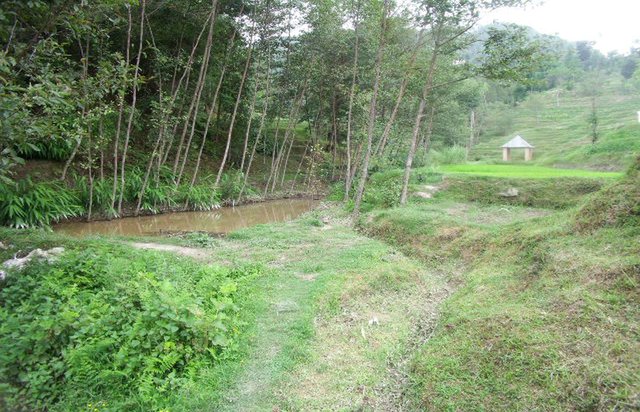
Sustainable land management using controlled gullying [Népal]
An indigenous technology to help control channelled water during the rainy season and conserve it during the dry season
- Compilateur : Shreedip Sigdel
2. Description de l'Approche de GDT
2.1 Courte description de l'Approche
Protected gullying is a sustainable land management practice initiated and maintained by the traditional community approach; it is based on indigenous knowledge and uses only locally available materials.
2.2 Description détaillée de l'Approche
Description détaillée de l'Approche:
Aims / objectives: Sustainable land management aims to prevent soil erosion and to increase productivity; it can take on different forms depending on the exigencies of the terrain.
Methods: In Kabhrepalanchok District, where the slope of the land is not too steep, farmers use gullies controlled using indigenous techniques to protect fertile agricultural land, to minimize erosion, and to help prevent landslides near villages.
For more than two hundred years, land users in jagidol (jagi=rice, dol=gully) villages practiced gully control and they have developed innovative methods for deployment and maintenance of gullies. Periodically, the whole community is involved in discussions for planning and implementation of new measures, but for the most part only routine repairs are needed and the individual farmers whose properties border the gullies shoulder the main responsibility for maintaining them. When severe flooding events cause many gullies to collapse, materials are collected locally and the whole village cooperates in the rebuilding. Both men and women are involved; men usually help with the heavy digging when new gullies are established or during crises when many gullies collapse at once and women are involved in the day-to-day maintenance of the gullies. Communities in villages higher up in the hills have used this approach for a long time; their gullies are more mature and well-entrenched and are reinforced by mature bio-engineering measures. Gullies in villages situated lower down the slope are usually more recently established and typically still require regular maintenance.
The jagidol village community, the Newari guthi (religious group) in the area, and the Hindus who worship the snake god Nagdevata and Shivadevata along the stream banks are particularly conscientious in maintaining the gullies that border the shrine(s). In this example, maintenance of the gullies is a collective effort through social networks.
2.3 Photos de l'approche
2.5 Pays/ région/ lieux où l'Approche a été appliquée
Pays:
Népal
Autres spécifications du lieu :
Sharada Batase VDC, Kabhrepalanchok
2.7 Type d'Approche
- traditionnel/ autochtone
2.8 Principaux objectifs de l'Approche
The Approach focused mainly on SLM with other activities (Religious, cultural and ecological significance)
To ensure the maintenance of the system of gullies that acts to help prevent soil erosion and protect against flooding. During the rainy season the gullies channel water away, and during the dry season they can be modified to collect water for irrigation. Maintenance is especially important during the rainy season because when water is not channelled many terraces can collapse simultaneously and the ensuing landslide can threaten the stability of the entire village.
The SLM Approach addressed the following problems: This approach suffers from a lack of institutional infrastructure. Since the group that maintains the gullies is not registered as a conservation team or an organization, it is not entitled to technical or financial support of any kind from government or non-governmental organizations. The research conducted by the community is not documented anywhere, it is passed on by word of mouth. A shortage of labour (or labour saving devices) is a persistent constraint in the maintenance of the gullies.
2.9 Conditions favorisant ou entravant la mise en œuvre de la(des) Technologie(s) appliquée(s) sous l'Approche
disponibilité/ accès aux ressources et services financiers
- entrave
For the labour needed to perform the maintenance. During the busy parts of the farming year there is little or no labour available for land management projects.
Treatment through the SLM Approach: Sustainable land management projects are scheduled for the dry season when farmers have fewer farming-related obligations.
cadre juridique (régime foncier, droits d'utilisation des terres et de l'eau)
- favorise
The existing land ownership, land use rights / water rights moderately helped the approach implementation: It is generally accepted that since the farmer whose land borders the gullies gets the most benefit by having access to the water, that it is his responsibility to maintain and repair them. In times of crises, when gullies collapse beyond his individual ability to repair them, he can ask the community for help.
- entrave
The landowner is mostly responsible
Treatment through the SLM Approach: The landowner is encouraged by others in the community to maintain the gullies that border of his/her land
connaissances sur la GDT, accès aux supports techniques
- entrave
Farmers are not fully aware of the best gullying practices
Treatment through the SLM Approach: New methods and the use of new materials can be learned from other projects implemented in nearby areas
autre
- entrave
Financial: To purchase tools and equipment needed for maintenance activities
Treatment through the SLM Approach: Local materials are used; the community makes in-kind and (occasionally) in-cash donations
3. Participation et rôles des parties prenantes impliquées dans l'Approche
3.1 Parties prenantes impliquées dans l'Approche et rôles
- exploitants locaux des terres / communautés locales
Generally the farmer owning the land that borders on the gullies maintains them.
Usually the gullies are dug by young men. Men are also involved when gullies collapse and heavy digging is needed. Women conduct routine maintenance throughout the year.
Si plusieurs parties prenantes sont impliquées, indiquez l'organisme chef de file ou l'institution responsable:
The elders in the community are the repositories of traditional knowledge and best practices on gullying. The community discusses with them and together they decide on a plan of action that best suits the existing conditions. The solution is usually implemented by the men during the dry season and the women maintain the gullies during the rainy season.
3.2 Participation des exploitants locaux des terres/ communautés locales aux différentes phases de l'Approche
| Participation des exploitants locaux des terres/ communautés locales | Spécifiez qui était impliqué et décrivez les activités | |
|---|---|---|
| initiation/ motivation | auto-mobilisation | The community as a whole decides when it needs to initiate sustainable land management in order to prevent erosion, to increase the amount of available farmland, and to protect the village from landslides. |
| planification | auto-mobilisation | The community plans to dig gullies during the dry season; during the monsoon they plant grasses whose roots help to anchor the structures. |
| mise en œuvre | auto-mobilisation | The land users implement protective measures during the times when they are not actively farming; they use all local materials |
| suivi/ évaluation | auto-mobilisation | Gullies are monitored routinely as part of normal farming activities; the gullies are maintained and repaired as needed. |
| Research | aucun |
3.4 Prises de décision pour la sélection de la Technologie/ des Technologies
Indiquez qui a décidé de la sélection de la Technologie/ des Technologies à mettre en œuvre:
- les exploitants des terres seuls (auto-initiative)
Expliquez:
Decisions on the method of implementing the SLM Technology were made by by land users* alone (self-initiative / bottom-up)
4. Soutien technique, renforcement des capacités et gestion des connaissances
4.3 Renforcement des institutions (développement organisationnel)
Des institutions ont elles été mises en place ou renforcées par le biais de l'Approche?
- non
4.4 Suivi et évaluation
Le suivi et l'évaluation font ils partie de l'Approche? :
Oui
Commentaires:
bio-physical aspects were regular monitored by land users through measurements; indicators: Gullies are regularly monitored by the land users but there is no formal reporting; the community observes the evolution of the approach
socio-cultural aspects were regular monitored by land users through observations; indicators: When there are temples or shrines near the gullies, these are also places of worship for Nagadevta (the snake god) and Shivadevata. The villagers make a special effort to maintain the gullies.
Continuity of the approach aspects were regular monitored by land users through observations; indicators: The community has for generations used gullying as a practice for sustainable land management.
There were few changes in the Approach as a result of monitoring and evaluation: The practice has not changed significantly for generations; however, the use of new materials and techniques can be observed in communities farther downhill where the practice is a more recent innovation.
5. Financement et soutien matériel externe
5.1 Budget annuel de la composante GDT de l'Approche
Si le budget annuel précis n'est pas connu, indiquez une fourchette:
- < 2 000
Commentez (par ex. principales sources de financement/ principaux bailleurs de fonds):
Approach costs were met by the following donors: local community / land user(s): 100.0%
5.2 Soutiens financiers/ matériels fournis aux exploitants des terres
Les exploitants des terres ont-ils reçu un soutien financier/ matériel pour la mise en œuvre de la Technologie/ des Technologies?
Non
5.3 Subventions pour des intrants spécifiques (incluant la main d'œuvre)
- aucun
Si la main d'œuvre fournie par les exploitants des terres était un intrant substantiel, elle était:
- volontaire
5.4 Crédits
Des crédits ont-ils été alloués à travers l'Approche pour les activités de GDT?
Non
6. Analyses d'impact et conclusions
6.1 Impacts de l'Approche
Est-ce que l'Approche a aidé les exploitants des terres à mettre en œuvre et entretenir les Technologies de GDT?
- Non
- Oui, un peu
- Oui, modérément
- Oui, beaucoup
Gullying helps to reduce the incidence of erosion, landslides, and floods as a result of which the dwellings in the village are more stable and everyone enjoys a greater sense of security.
Est-ce que l'Approche a autonomisé les groupes socialement et économiquement défavorisés?
- Non
- Oui, un peu
- Oui, modérément
- Oui, beaucoup
Did other land users / projects adopt the Approach?
- Non
- Oui, un peu
- Oui, modérément
- Oui, beaucoup
There are a few incidences where farmers from neighbouring valleys have observed the gullying and have implemented similar sustainable land management measures in their own villages.
Did the Approach lead to improved livelihoods / human well-being?
- Non
- Oui, un peu
- Oui, modérément
- Oui, beaucoup
the water and soil conservation afforded by the gullies means that there is more arable land available for quality crop production. More abundant crops ensure a marked improvement in the health and wellbeing of the whole community.
Did the Approach help to alleviate poverty?
- Non
- Oui, un peu
- Oui, modérément
- Oui, beaucoup
Farmers can now produce more crops so that families have more food available and can even earn some cash income by selling some of their excess produce. The entire village has benefited from this approach and everyone is better off.
6.2 Principale motivation des exploitants des terres pour mettre en œuvre la GDT
- augmenter la production
creating better soil conditions and making water available for irrigation
- augmenter la rentabilité/ bénéfice, rapport coûts-bénéfices
when better quality farm land is available and when farmer have access to water for irrigation more
- Risk Minimization
flooding, soil erosion (runoff), and landslides are a constant threat for hillside farmers.
6.3 Durabilité des activités de l'Approche
Les exploitants des terres peuvent-ils poursuivre ce qui a été mis en œuvre par le biais de l'Approche (sans soutien extérieur)?
- incertain
Si non ou incertain, spécifiez et commentez:
In recent times there is a shortage of local labour and volunteers. Some form of subsidy or external aid will be needed to support this land management practice and keep it sustainable. With funding, the village can purchase better materials and create longer lasting structures which need less maintenance.
6.4 Points forts/ avantages de l'Approche
| Points forts/ avantages/ possibilités du point de vue du compilateur ou d'une autre personne ressource clé |
|---|
| The community works together for the benefit of all. (How to sustain/ enhance this strength: Continue to support the community in their traditional land management practices.) |
|
Everyone's suggestions, including those of nearby communities, are taken into serious consideration when planning sustainable land management. (How to sustain/ enhance this strength: Continue to promote a regard for others sharing the same landscape) |
6.5 Faiblesses/ inconvénients de l'Approche et moyens de les surmonter
| Faiblesses/ inconvénients/ risques du point de vue du compilateur ou d'une autre personne ressource clé | Comment peuvent-ils être surmontés? |
|---|---|
| There is no formal planning and no contact with either the local authorities or potential funding agencies for conservation work | Formalize planning and implementation and become recognized as a legitimate conservation group. |
| Farmers are leaving the area in search of paid employment. New actors are moving into the area and the larger community is changing. There are recurrent incidents of land use change such as brick factories moving into the area. | The government can institute zoning to regulate what land is deemed for cultivation only. |
7. Références et liens
7.1 Méthodes/ sources d'information
- visites de terrain, enquêtes sur le terrain
- interviews/entretiens avec les exploitants des terres
Liens et modules
Développer tout Réduire toutLiens

Sustainable land management using controlled gullying [Népal]
An indigenous technology to help control channelled water during the rainy season and conserve it during the dry season
- Compilateur : Shreedip Sigdel
Modules
Aucun module trouvé


